Project
Description
Team
Members
AGN
Samples
Useful Links:
THE MOJAVE PROGRAM HOMEPAGE
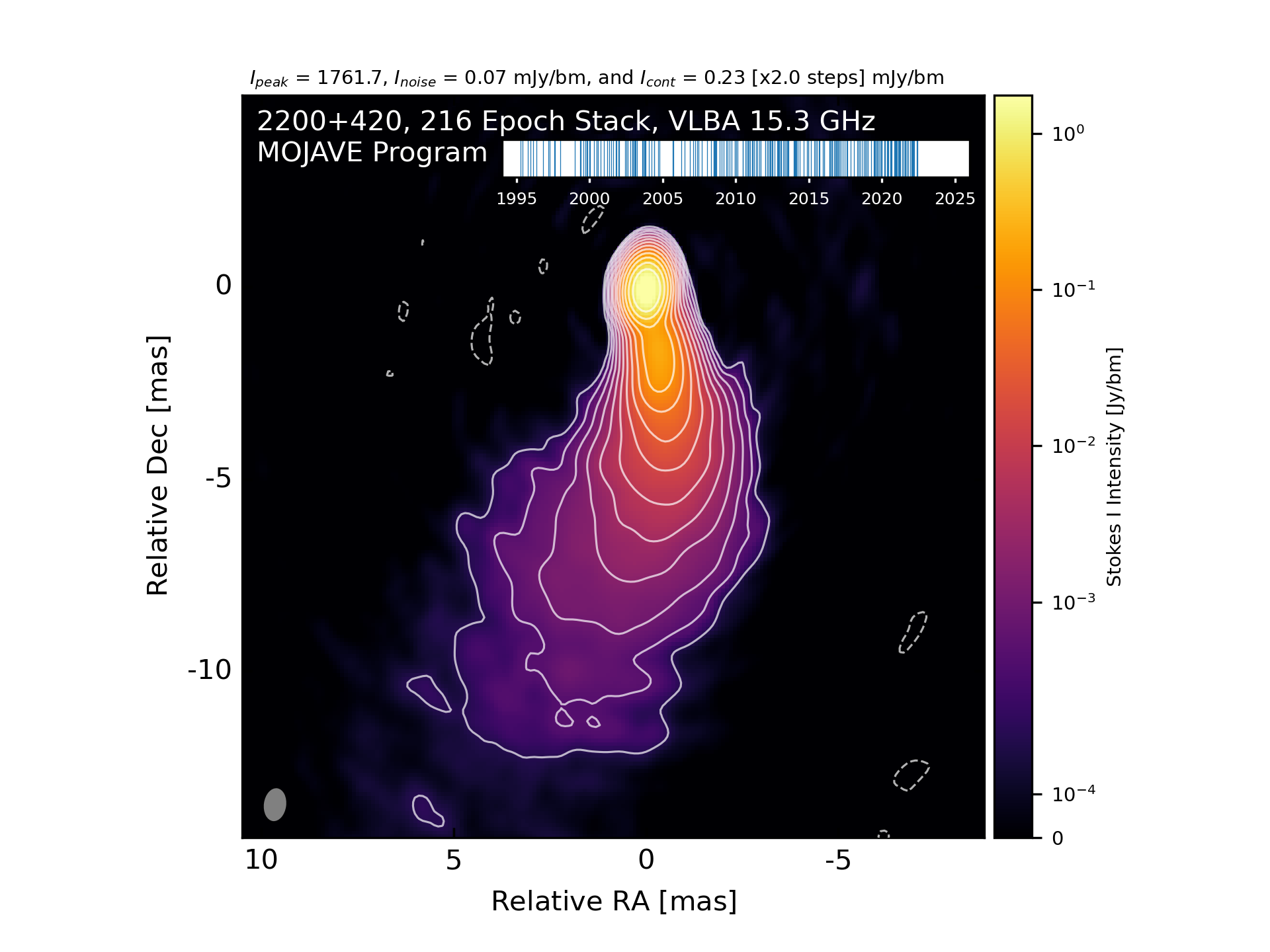 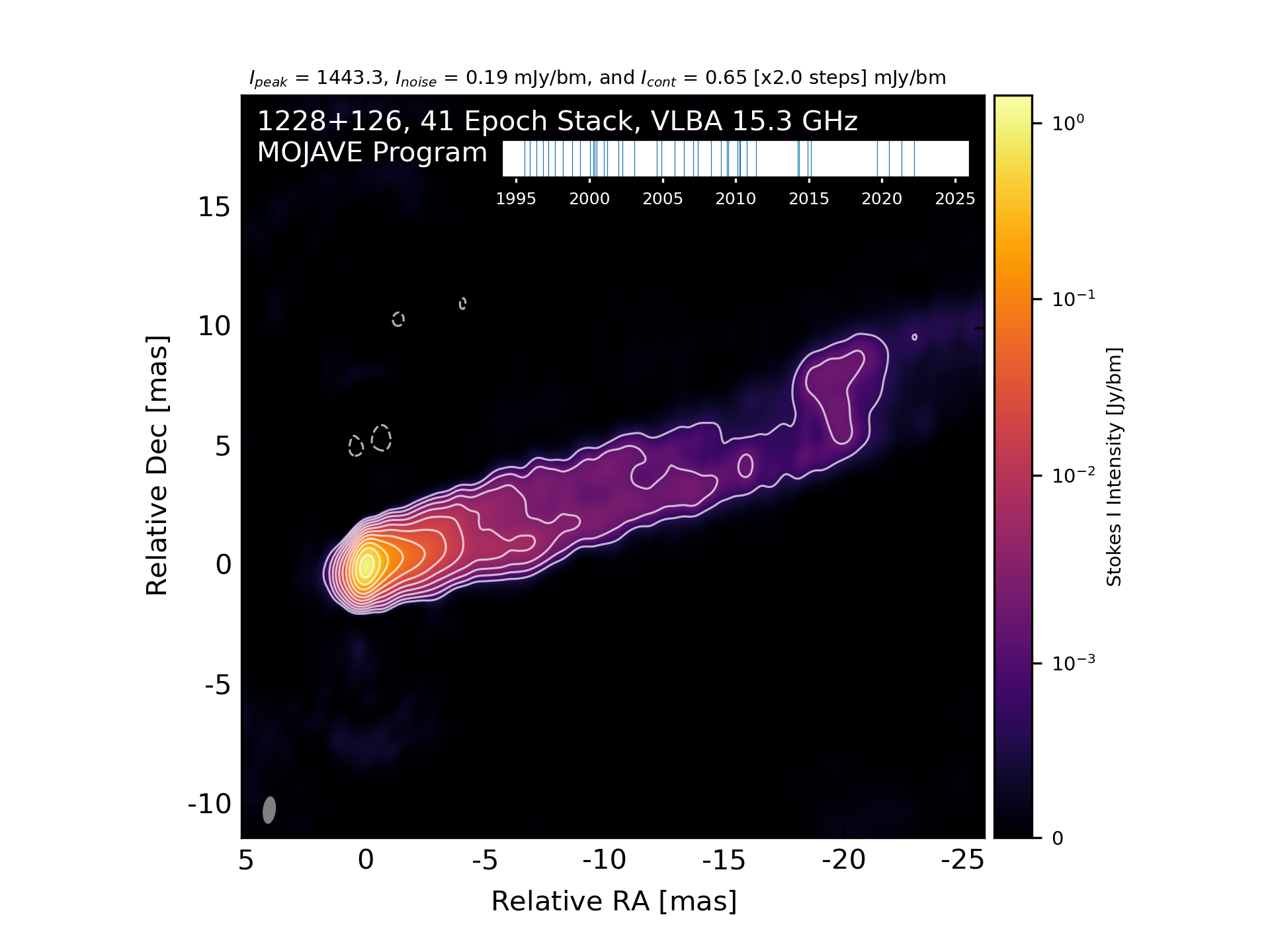 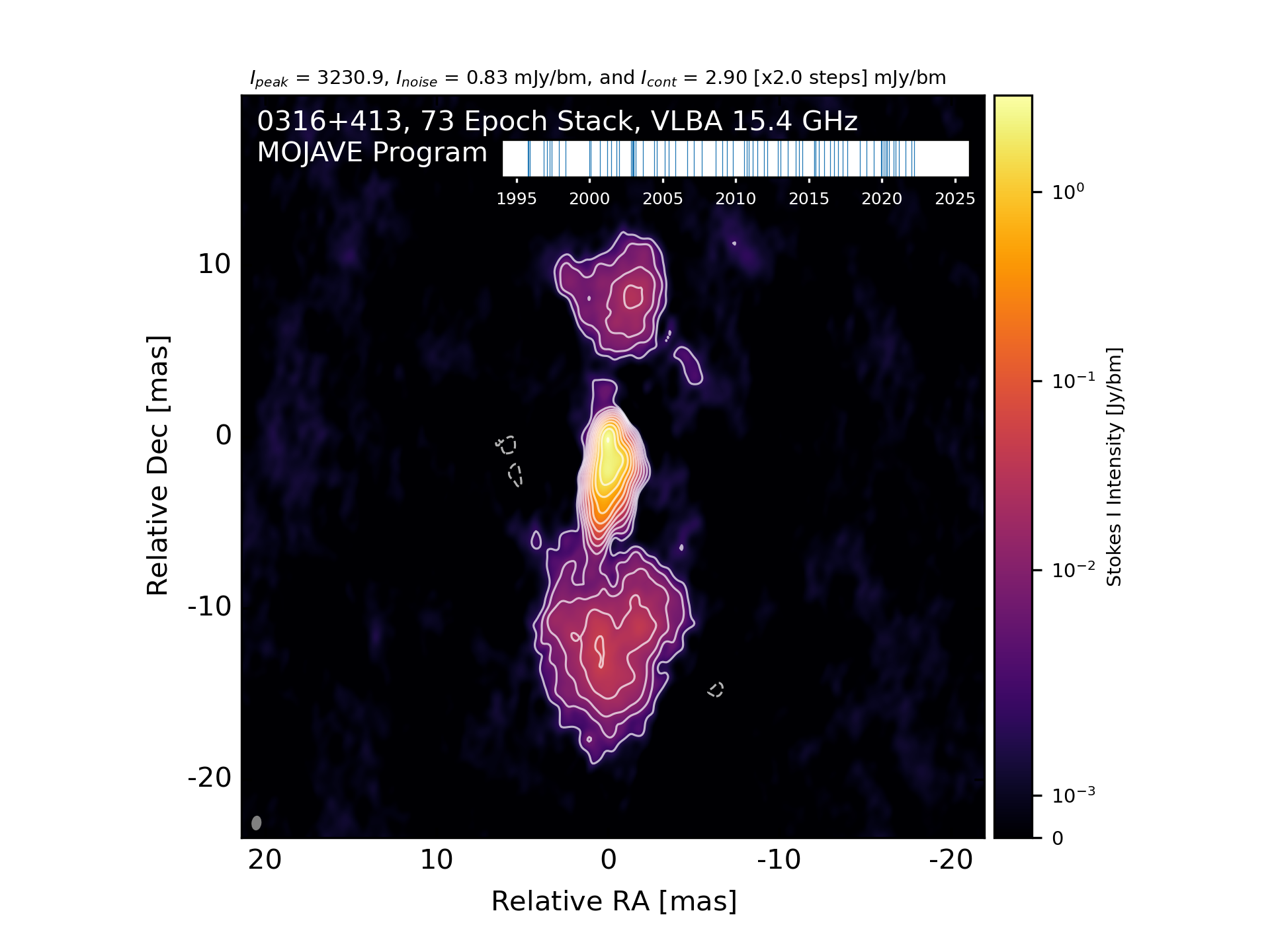 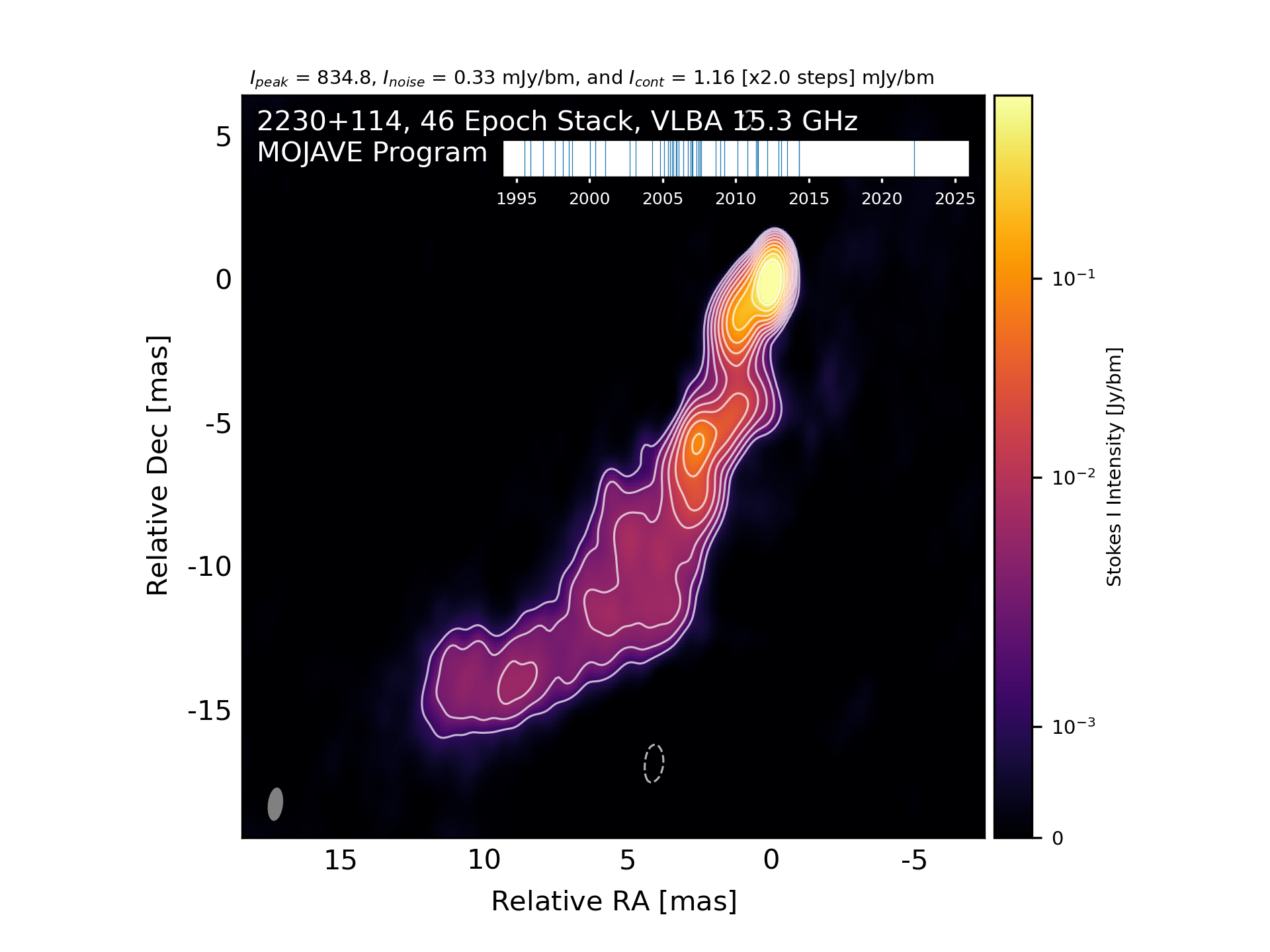 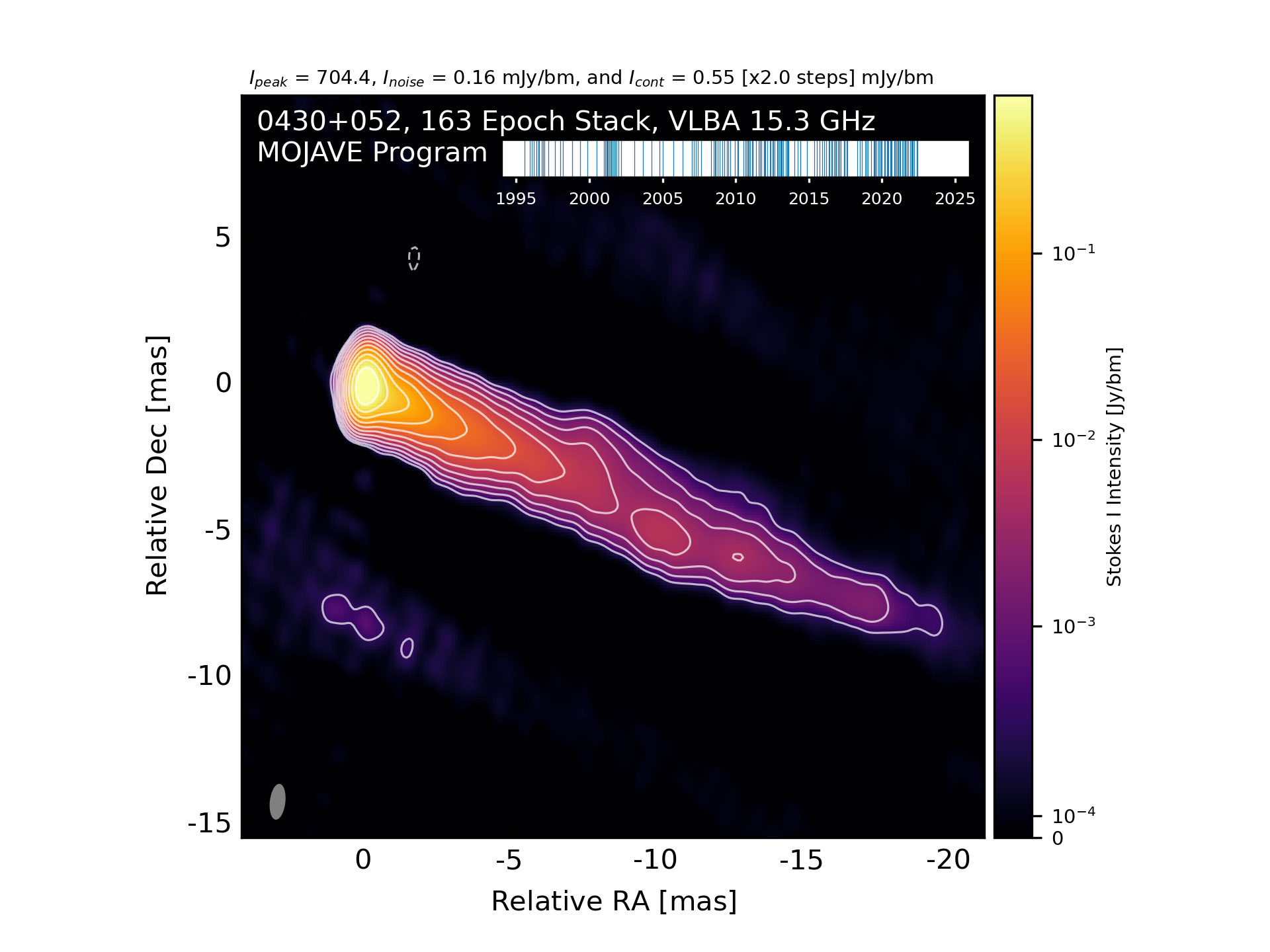 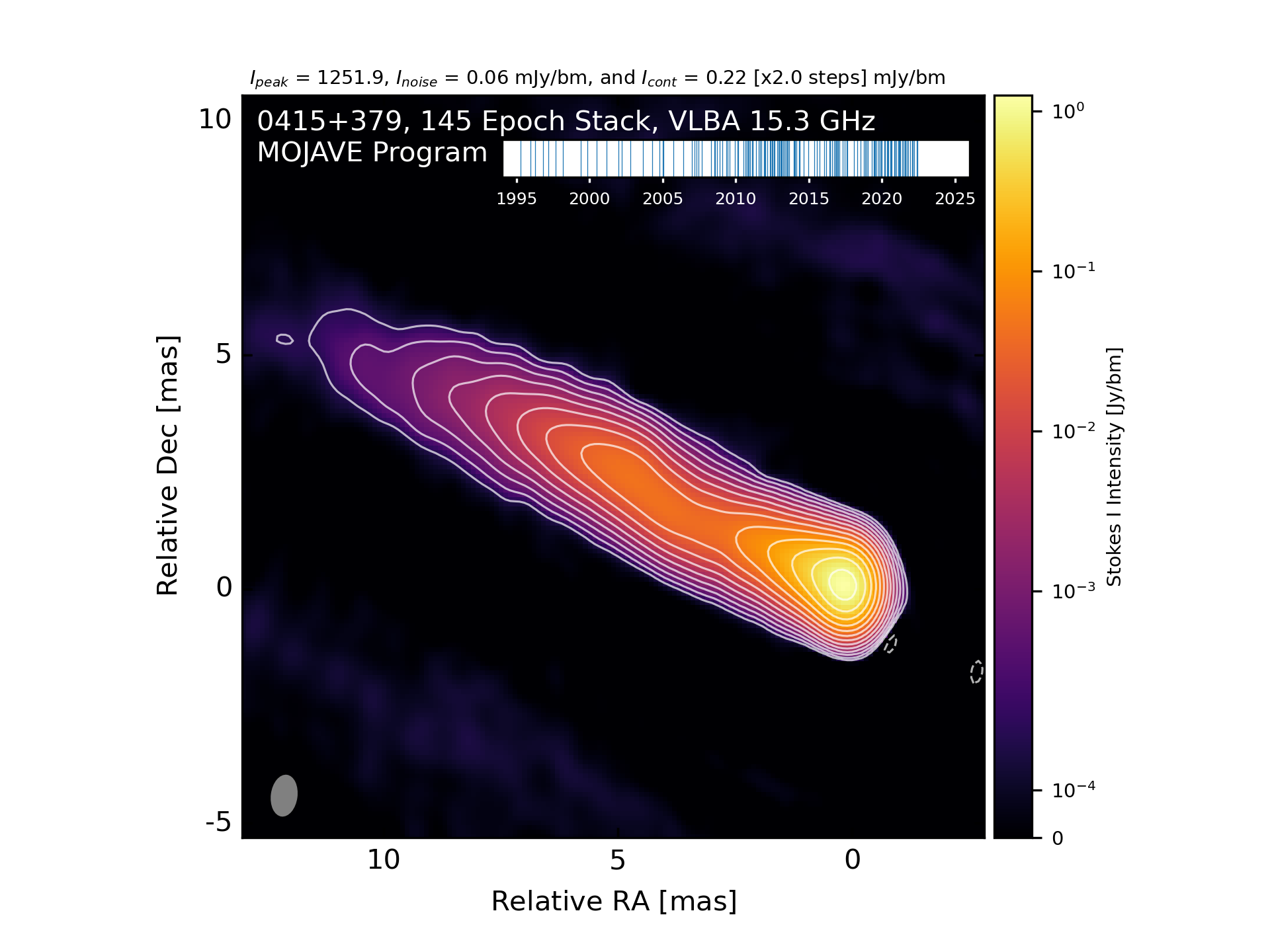 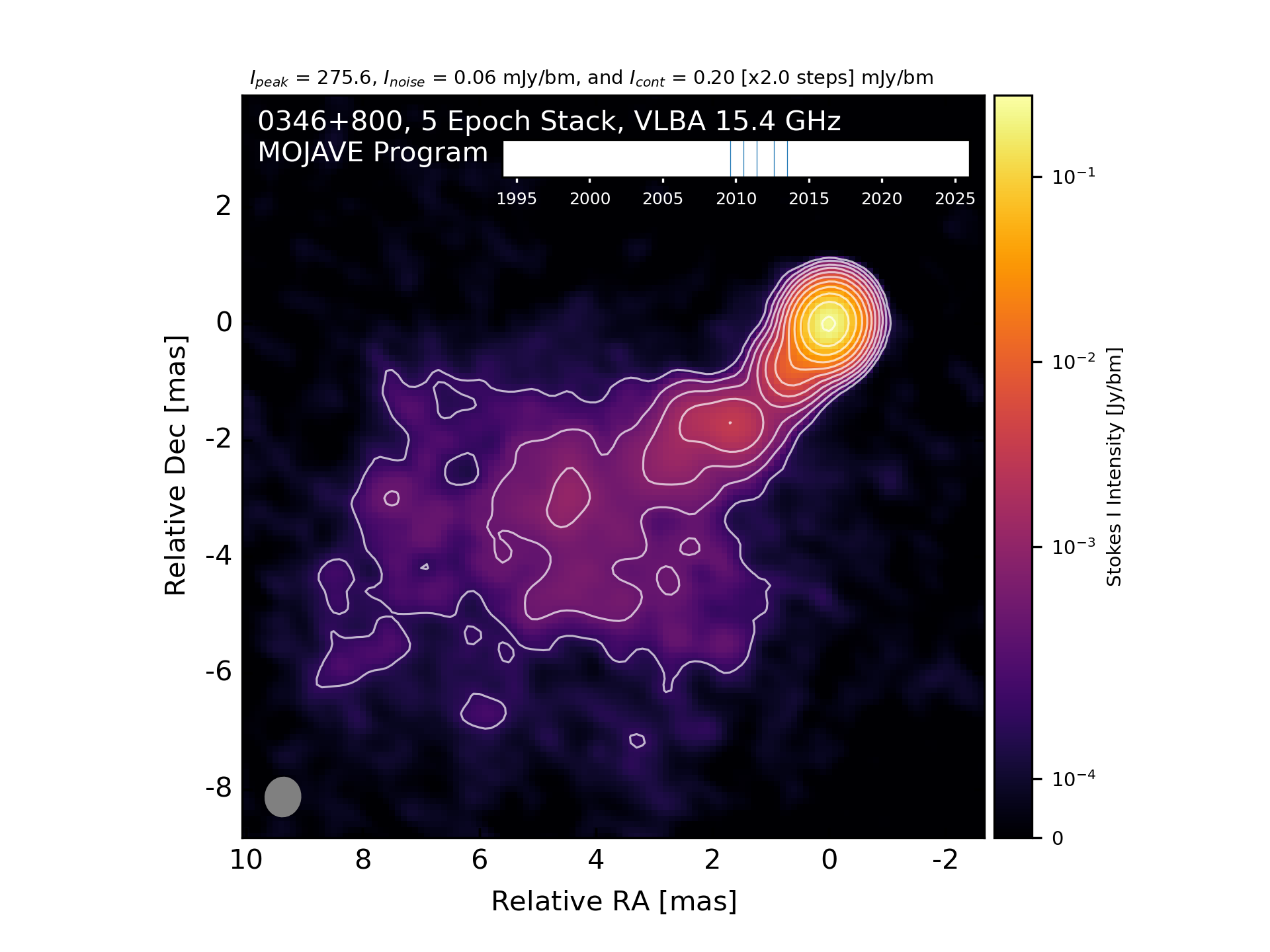 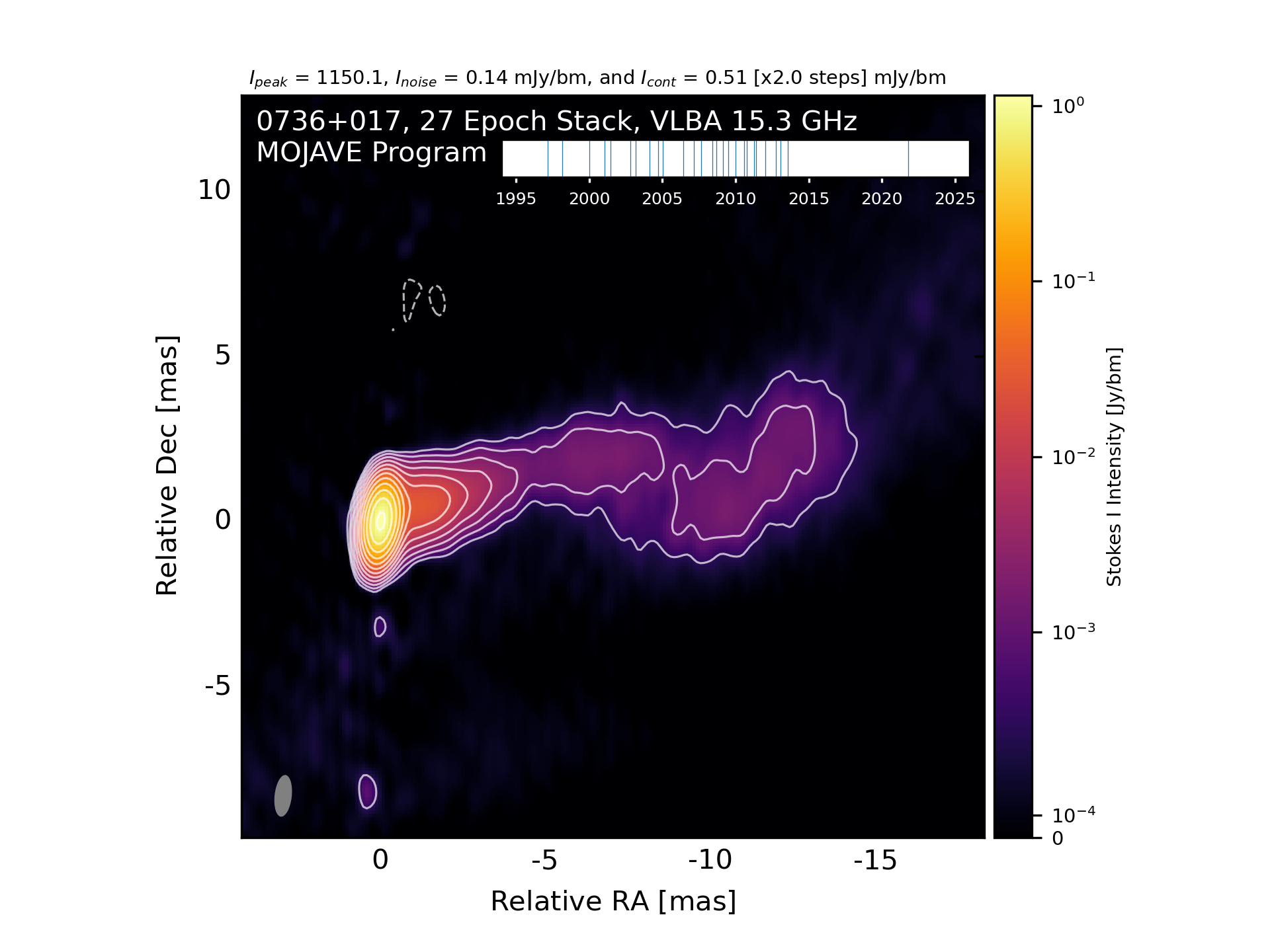 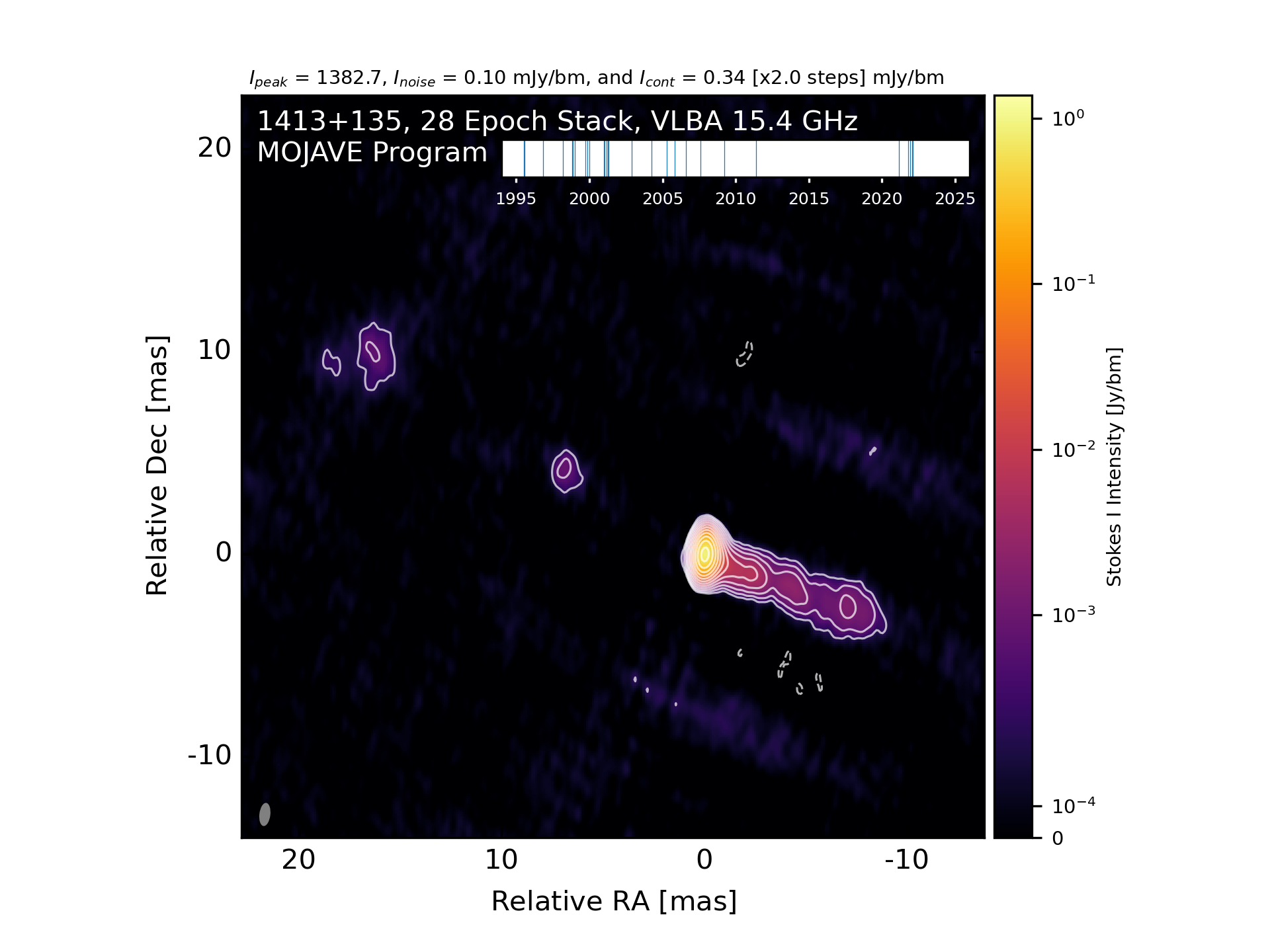 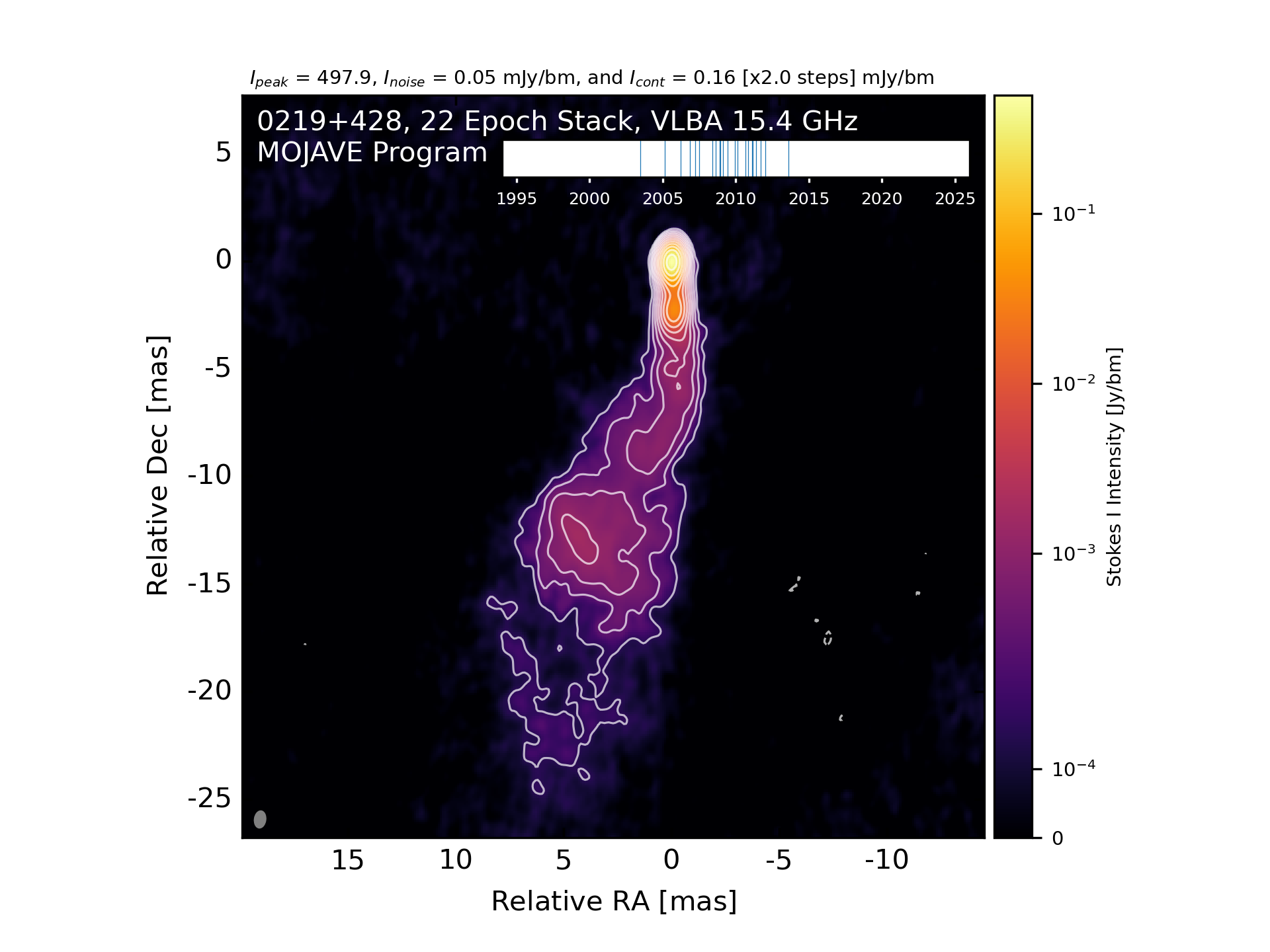 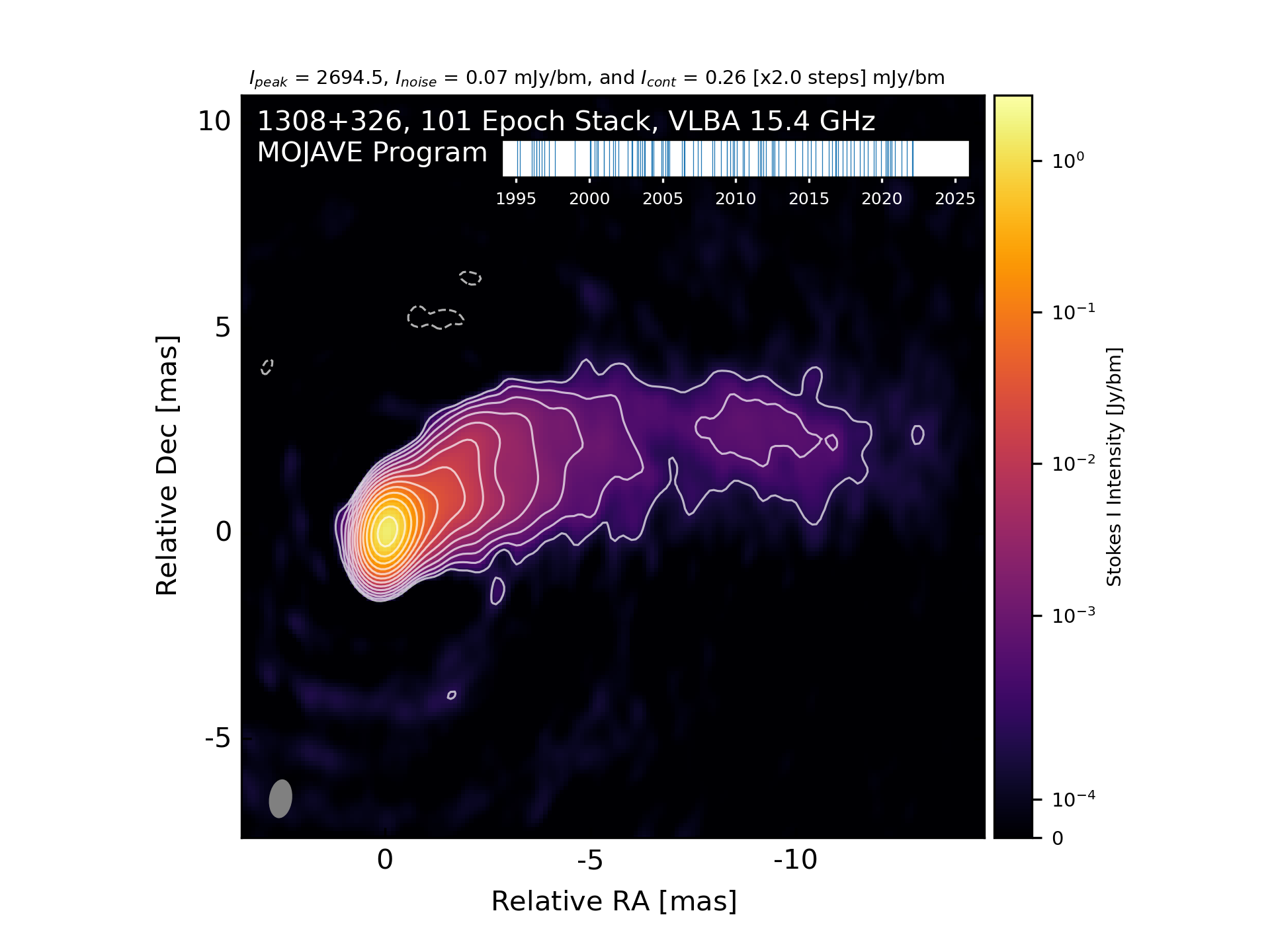 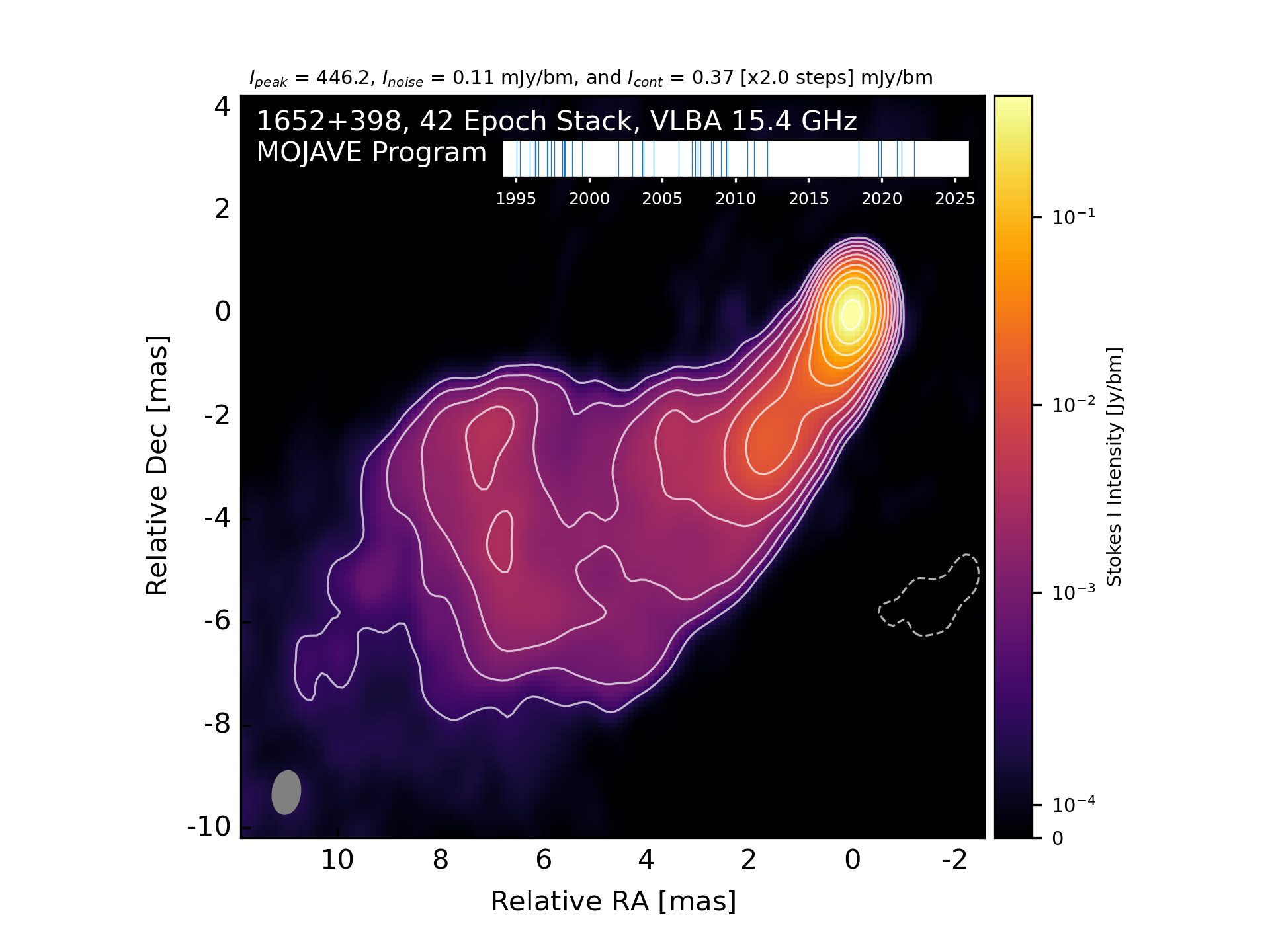 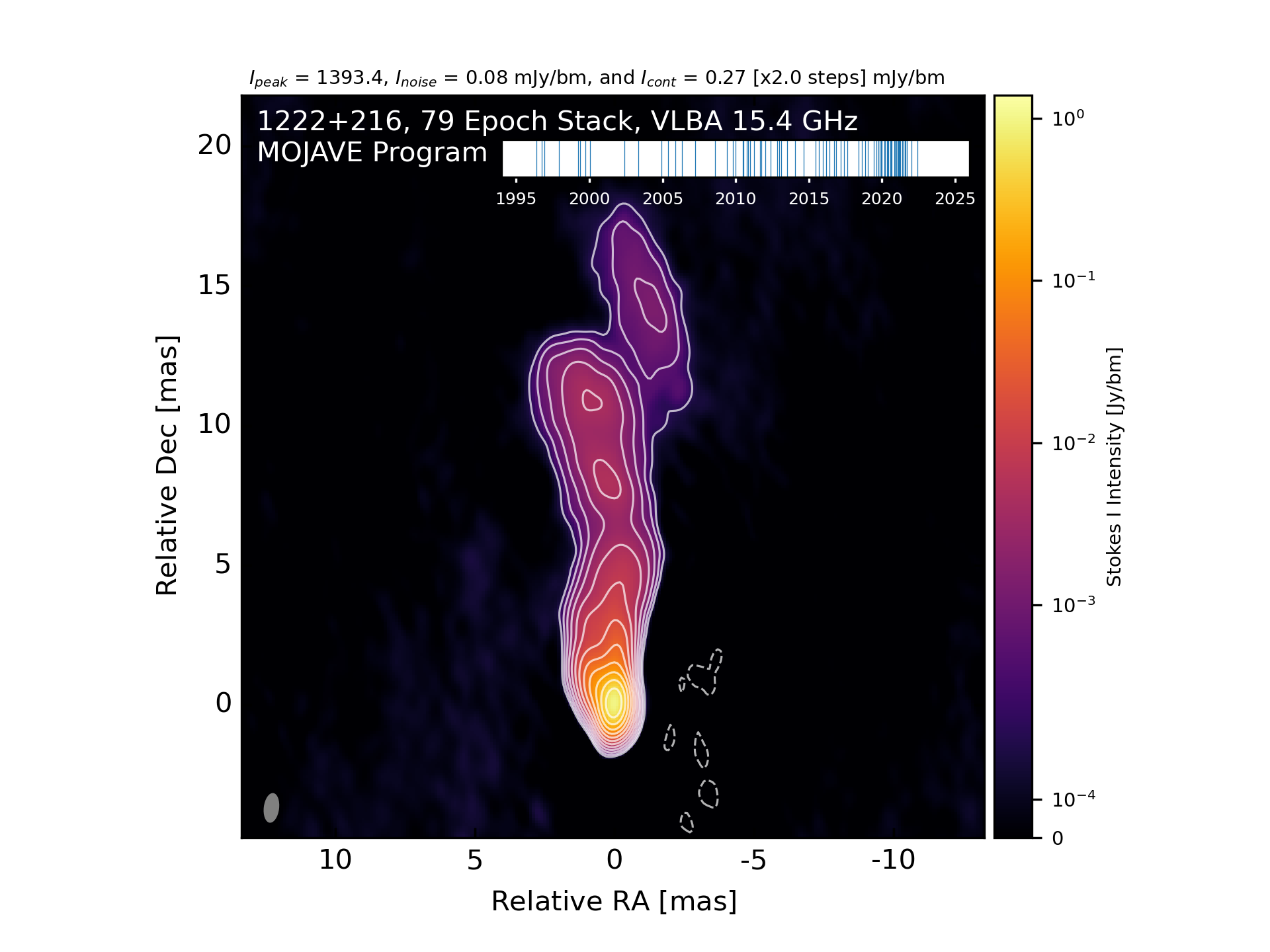 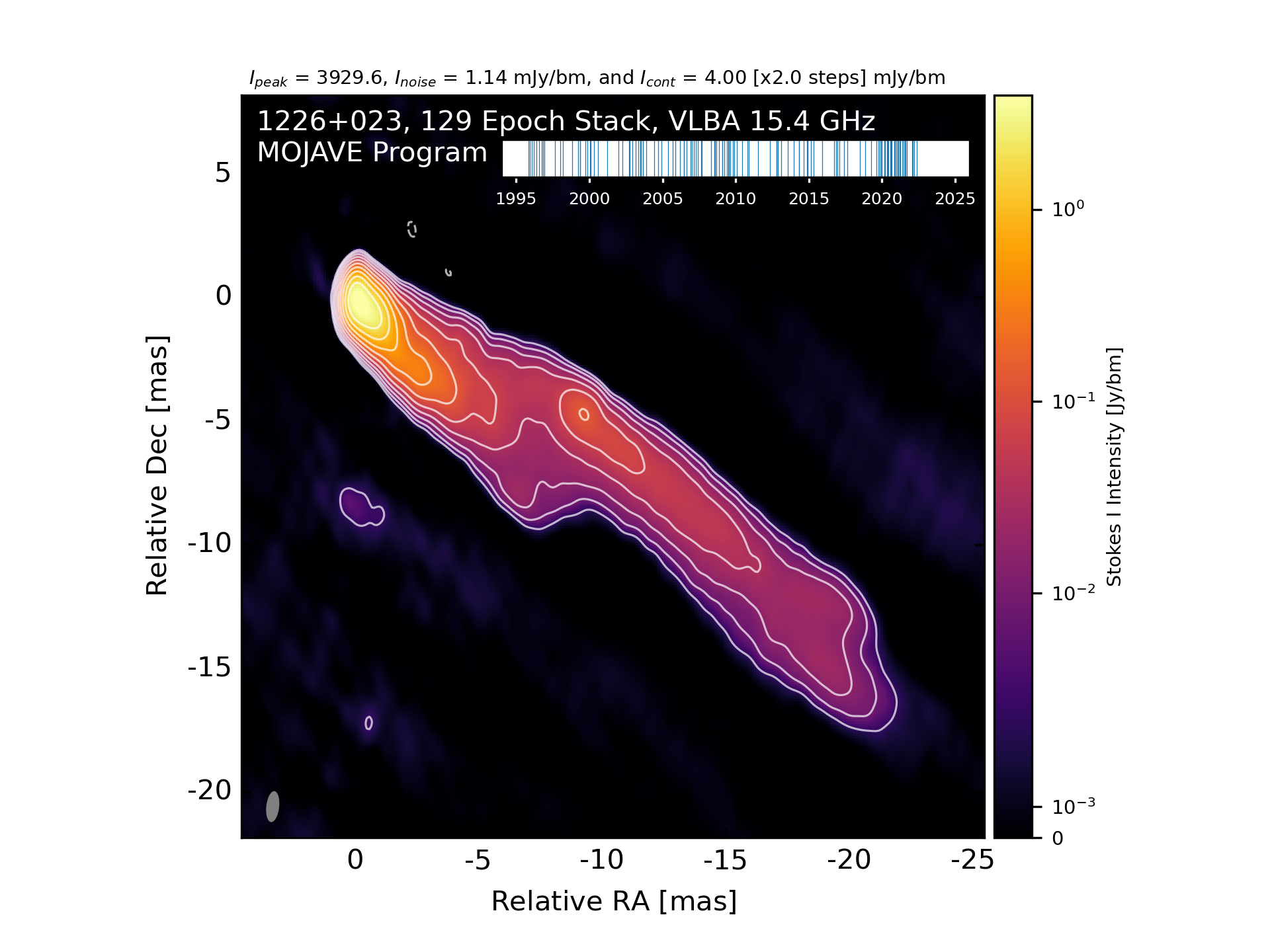 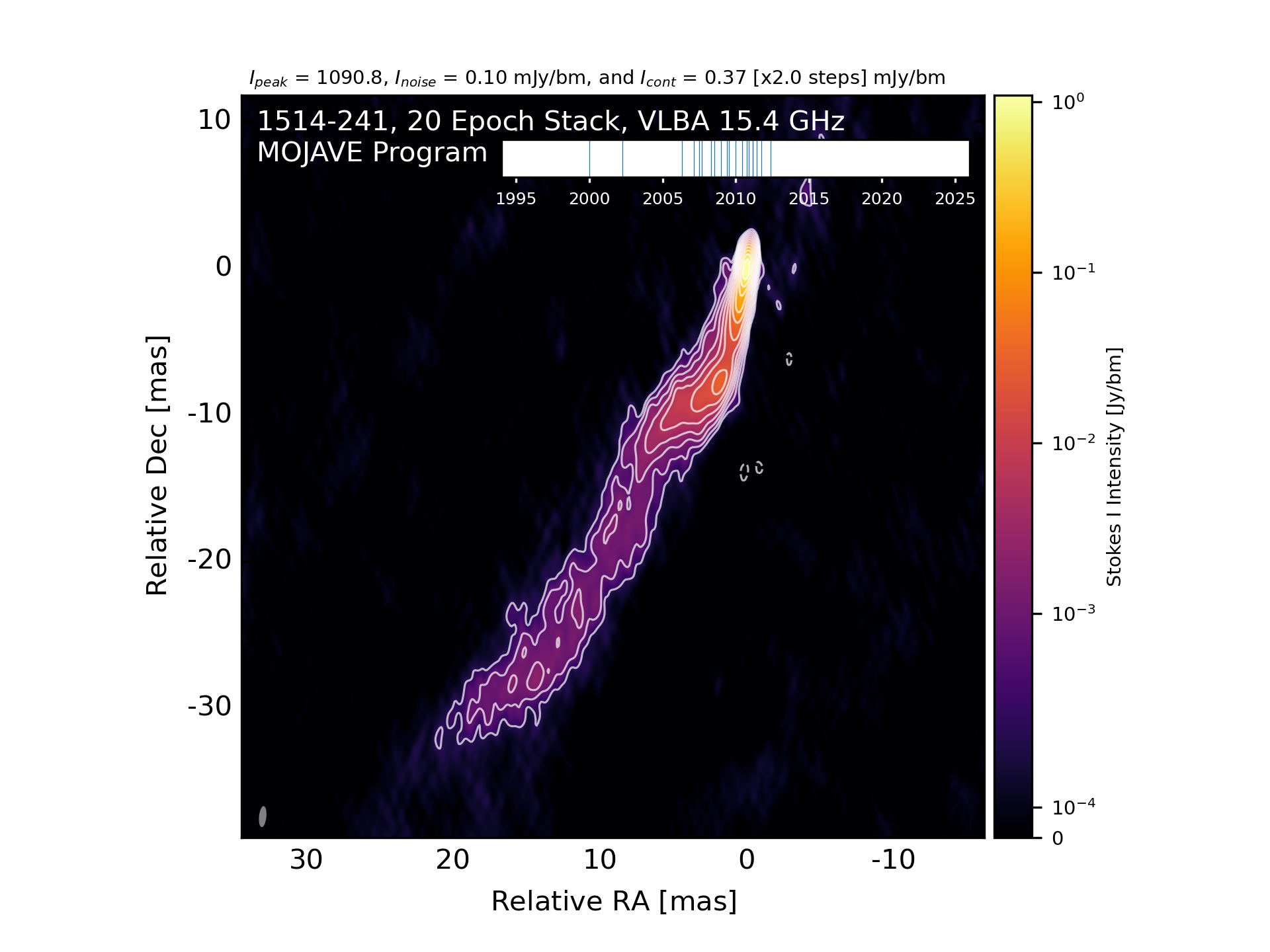 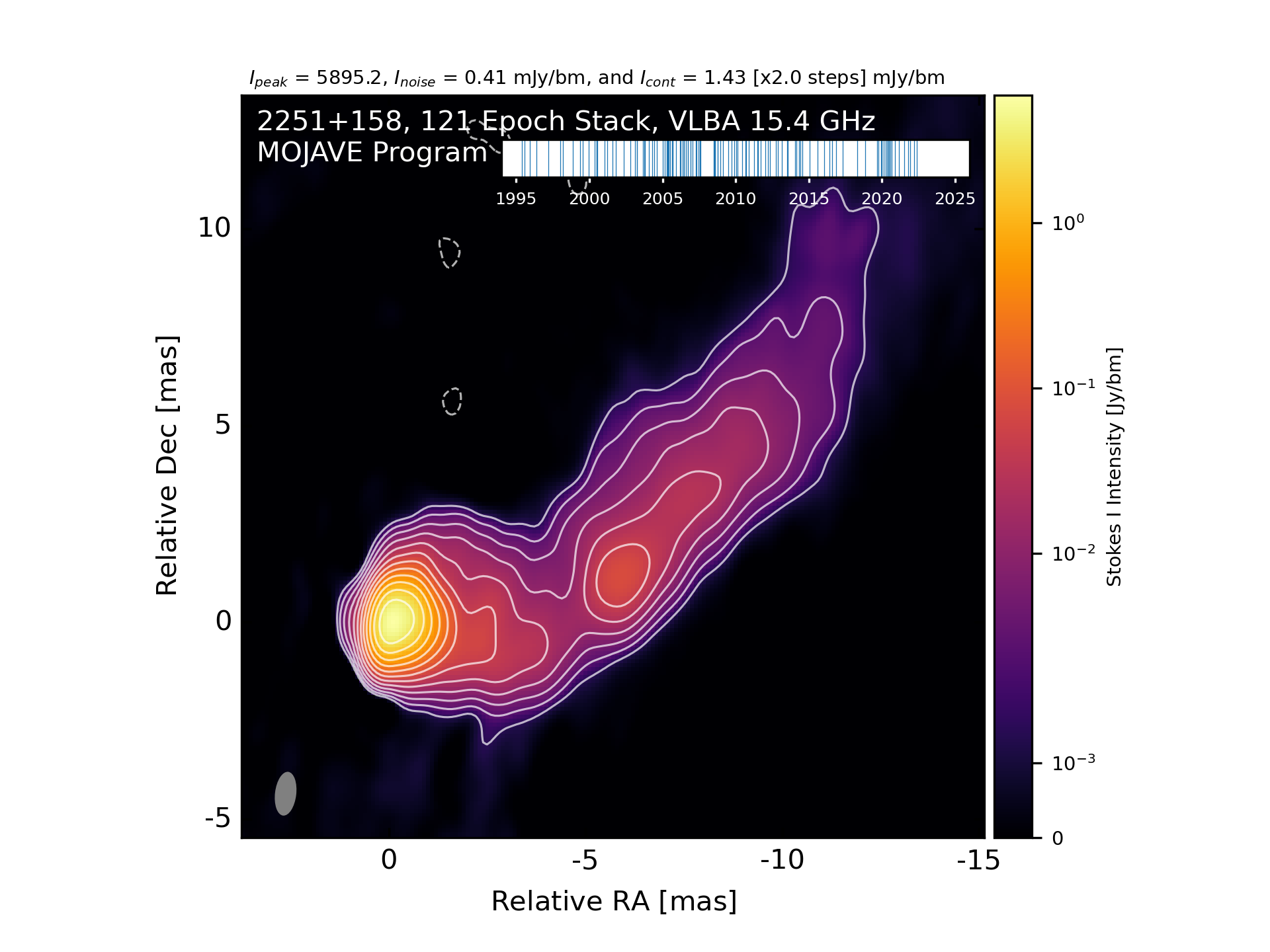 |
|
MOJAVE (Monitoring
Of Jets
in
Active galactic
nuclei with VLBA
Experiments) is a
long-term program to monitor radio brightness and
polarization variations in jets associated with active
galaxies visible in the northern sky. Approximately 1/3 of
these were observed from 1994-2002 as part of the VLBA 2
cm Survey. These jets are powered by the accretion of
material onto billion-solar-mass black holes located in
the nuclei of active galaxies. Their rapid brightness
variations and apparent
superluminal
motions indicate that they contain highly energetic
plasma moving nearly directly at us at speeds approaching
that of light. Our observations are made with the
world's highest resolution telescope: the Very
Long Baseline Array (VLBA) at wavelengths of 7 mm,
1.3 cm, and 2 cm, which enables us to make full
polarization images with an angular resolution better than
1 milliarcsecond (the apparent separation of your car's
headlights, as seen by an astronaut on the Moon). We are
using these data to better understand the complex
evolution and magnetic field structures of these jets on
light-year scales, close to where they originate in the
active nucleus, and how this activity is correlated with
a high energy electromagnetic and neutrino emission. For astronomers: All calibrated (u,v) visibility and FITS data are available via html links on the source pages. If you are interested in Stokes Q,U,V (linear and circular polarization) FITS images, please contact us.
WHAT'S
NEW:
The new MOJAVE three year large proposal has been approved by NRAO; 15 GHz VLBA observations will continue until the middle of 2027:
The MOJAVE team is happy to report that its new VLBA proposal (code BK255) for 864 hours is approved by the NRAO. We will continue observing one 24-hrs long segment every month until the middle of 2027.
In each 24 hour segment we will observe 40 targets from a pool of 65 AGN jets exhibiting accelerating features and/or swinging nozzles, and 147 AGN from the MOJAVE 1.5 Jy Quarter Century sample that are in the IceCube northern sky footprint (J2000 declination between -15 degrees and +40 degrees).
Correlated data will be made public immediately after correlation from the NRAO data archive, imaged results - from this website as soon as data processing and calibration is finished by the team.
MOJAVE Stokes I stacked images are updated, FITS made public:
The MOJAVE team has performed a major update of stacked images which are based now on the new deep CLEANing approach (see the previous news). Moreover, results in a form of FITS images are now also made available publickly.
Global MOJAVE data archive update:
The MOJAVE team has performed a global data archive update in January 2024.
This includes the following major changes.
(i) The deep CLEANing of all images is now utilizing the entropy-based stopping criterion, see for details our recent paper in Astronomical Journal. This results in better noise properties and estimates.
(ii) The final deep CLEANing is performed with CLEAN boxes for selected targets with a very rich structure or uv-coverage limited dynamic range. This results in a significant improvement in Stokes I images, including
3C84,
1055+018,
1222+216,
3C273,
M87,
1345+125,
1546+027,
3C345,
1652+398,
1730-130,
1828+487.
(iii) We have introduced IF- (or frequency) dependent EVPA calibration corrections to address a calibration issue described here. This issue is still under investigation by NRAO, but our correction has resulted in increased coherence in many epochs of our multi-IF polarization data. This, in turn, increased the quality of our linear polarization images.
(iv) Plots are now produced with color schemes chosen for the ease of use of people with color vision deficiency. A high resolution montage plot is introduced which combines all plots for a given source and epoch together.
We ask our colleagues to contact us in case of any questions or issues being found.
MOJAVE Observations of a Supermassive Binary Black Hole Candidate:
VLBA images from the MOJAVE program have played an important role in
the interpretation of the sinusoidally-varying radio emitting AGN
PKS
2131-031. The latter has been identifed as a binary supermassive black
hole system in a
Caltech press release and accompanying
paper in the Astrophysical Journal.
MOJAVE observations of a neutrino AGN candidate: On December 8, 2021, the IceCube collaboration issued a high energy
neutrino event detection alert: IceCube-211208A
. Subsequent multi-wavelength observations of the bright blazar
PKS B0735+178 located inside the 90% confidence region have
indicated that it entered a flaring state. The blazar is a member of the MOJAVE 1.5 Jy Quarter-Century flux density-limited sample and is regularly monitored by the MOJAVE program with the VLBA at 15 GHz. The latest MOJAVE observations took place on Dec. 10, 2021 and showed no indications of the source being in an atypical state.
New Paper on Intrinsic Jet Properties: We have completed a new brightness temperature analysis of a sample of 447 AGN jets from the MOJAVE program. We use the observed median brightness temperatures combined with the measured jet kinematics to find a typical intrinsic Gaussian brightness temperature of 4.1 x 10^10 K, suggesting jet cores are at or below equipartition between particle and magnetic field energy in their median state. We use this intrinsic value to estimate Doppler factors for all 447 jets in our sample, and for the 309 jets with full kinematic information, we also estimate their Lorentz factors and angles to the line of sight. Within the BL Lac optical class, we find that high-synchrotron peaked BL Lacs have smaller Doppler factors, lower Lorentz factors, and larger angles to the line of sight than intermediate or low-synchrotron peaked BL Lacs. We find a strong correlation between gamma-ray luminosity and Doppler factor for the detected sources. The manuscript has been accepted for publication in ApJ and is available at https://arxiv.org/abs/2109.04977
New Kinematics Analysis Paper: We have analyzed the
pc-scale jet kinematics of 447 bright radio-loud AGNs
based on 15 GHz VLBA data obtained between 1994 August 31
and 2019 August 4. Most of the jets show variations of 10 to 50 degrees in their inner jet sky position angles (PAs) over time, although some range up to 200 degrees. Fermi LAT gamma-ray associated AGN also tend to have more variable PAs than the non-LAT AGN in our sample. We attribute these trends to smaller viewing angles for the lower spectral peaked and LAT-associated jets. We identified 13 AGN where multiple features emerge over decade-long periods at systematically increasing or decreasing PAs. Since the ejected features do not fill the entire jet cross-section, this behavior is indicative of a precessing flow instability near the jet base. The manuscript has been published in ApJ and is available at https://ui.adsabs.harvard.edu/abs/2021ApJ...923...30L/
Continuing MOJAVE VLBA Observations: The MOJAVE program has been approved with 'A' queue priority to continue monthly 15 GHz VLBA observations until August 2024. In each 24 hour segment we will observe 40 targets from a pool of 68 AGN jets exhibiting accelerating features and/or swinging nozzles, and 147 AGN from the MOJAVE 1.5 Jy Quarter Century sample that are in the IceCube northern sky footprint (J2000 declination between -15 degrees and +40 degrees). We are also pleased to announce a new data sharing agreement with the IceCube collaboration to investigate potential sources of extragalactic high energy neutrinos. VLBA Flux Density Scaling Issue: The MOJAVE team, working with the OVRO 40m AGN monitoring group, has discovered a systematic error in the flux densities of all VLBA 15 GHz observations taking place after a date that lies between 2019 April 16 and 2019 May 16. All observations after that date have correlated flux densities that are between 10% and 20% too low. The MOJAVE team and NRAO are currently investigating the issue. In the interim we have used OVRO measurements to correct the flux density scaling of VLBA data in the MOJAVE archive up to and including the 2022 Jan 3 epoch.
Combined 11.5 yr Fermi-LAT and 15 GHz VLBA light curves:
For 377 4FGL sources detected by Fermi-LAT and observed within the MOJAVE program (at 5 or more VLBA epochs) we have constructed both weekly and adaptive (target relative flux uncertainty of 20%) binned gamma-ray light curves since Aug 2008 till the end of 2019 (594 weeks). The light curves are available from the individual AGN links on the data archive page, and are complemented by measurements of the 15 GHz total VLBA flux densities. To be published in Kramarenko et al. (in prep.).
Press release:
https://www.nasa.gov/feature/goddard/2020/nasa-missions-explore-a-tie-fighter-active-galaxy
: Members of the MOJAVE team and Aneta
Siemiginowska of the Chandra X-ray Center have used
observations from the VLBA, Fermi and Chandra to study
a young gamma-ray emitting AGN with an unusual
shape caused by intermittent jets that are
creating lobes of expanding plasma. The study has been
published in the Astrophysical
Journal.
New Individual AGN Jet
Paper Published: The MOJAVE team has published a
detailed study of stationary features in the jet of BL Lac
(Arshakian
et al. 2020).
Press release:
https://mipt.ru/english/news/cosmic_quasars_embrace_1970s_fashion_trend
: Team member Yuri Y. Kovalev (Lebedev Physical
Institute, and Moscow Institute of Physics and Technology)
has led a study
using epoch-stacked image data from the MOJAVE survey
(available on the individual
AGN source pages). We have found that 10 AGN jets at
redshift < 0.07 show a transition from a parabolic to
conical shape. This suggests that this geometry transition
may be a common effect in AGN jets. The break is found to
occur at 105-106
gravitational radii from the active nucleus.
MOJAVE Flux
Density-Limited Sample (1.5JyQC): Using data
from the VLBA, UMRAO, RATAN-600, and OVRO-40m telescopes,
we have constructed a new
complete '1.5 Jy Quarter Century' sample consisting
of all 232 non-lensed AGN north of declination -30 degrees
known to have exceeded 1.5 Jy in VLBA flux density at 15
GHz between 1994.0-2019.0.
VLBA
L Band Data: In 2010, D. Gabuzda and
collaborators at Univ. College Cork observed the original
MOJAVE AGN sample at 4 frequencies in L Band with the VLBA
to investigate jet polarization and Faraday rotation
properties. We have added the preliminary u,v visibility
data and images from this
program to the individual MOJAVE source pages in our
data
archive. Blazar Monitoring Program List: Most of the blazars in MOJAVE are monitored at other wavelengths by a variety of instruments. This blazar monitoring list page contains a sortable table of all blazars known to be monitored at optical wavelengths, as well as known TeV-emitting AGNs and MOJAVE-monitored sources. Superluminal Motion Demonstration Applet and Lab Activities: Prof. Dan Homan of Denison University has developed a 3-D Vpython-based simulation of superluminal motion. The Vpython applet and an accompanying laboratory exercise for an introductory astronomy level course can be accessed at http://personal.denison.edu/~homand/superluminal/ Joint Fermi-MOJAVE papers: We have found several strong connections between the VLBA radio jet properties of MOJAVE blazars and their Fermi-detected gamma-ray emission. Details have been published in Lister et al. 2011, in Pushkarev, Kovalev, & Lister 2010, Savolainen et al. 2010, Pushkarev et al. 2009, Lister et al. 2009, and Kovalev et al. 2009. In addition, we continute to contribute to multiwavelength studies of individual AGN, e.g. 3C390.3: Arshakian et al. 2010, 1510-089: Abdo et al. 2010, 3C 454.3: Vercellone et al. 2010, 1502+106: Abdo et al. 2009, J0948+0022: Abdo et al. 2009, and NGC 1275: Abdo et al. 2009. For a full list please visit our publications page.
Support for the MOJAVE program includes ERC grants 101142396 and 101018682 under the European Union's Horizon 2020 Research and Innovation Programme, NASA-Fermi grants 80NSSC19K1579,
NNX15AU76G and NNX12A087G.
Any opinions, findings, and conclusions or
recommendations expressed on this website are those of
the authors and do not necessarily reflect the views of
ERC or NASA. The National Radio Astronomy Observatory is a
facility of the National Science Foundation operated
under cooperative agreement by Associated Universities,
Inc.
|

Home | Science | AGN Samples | Data Archive | Status | Publications | Movies | RM Maps | α Maps | People | Outreach |